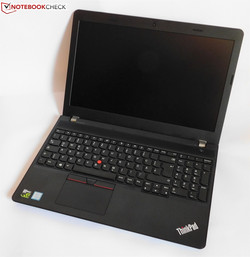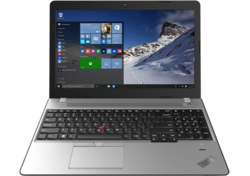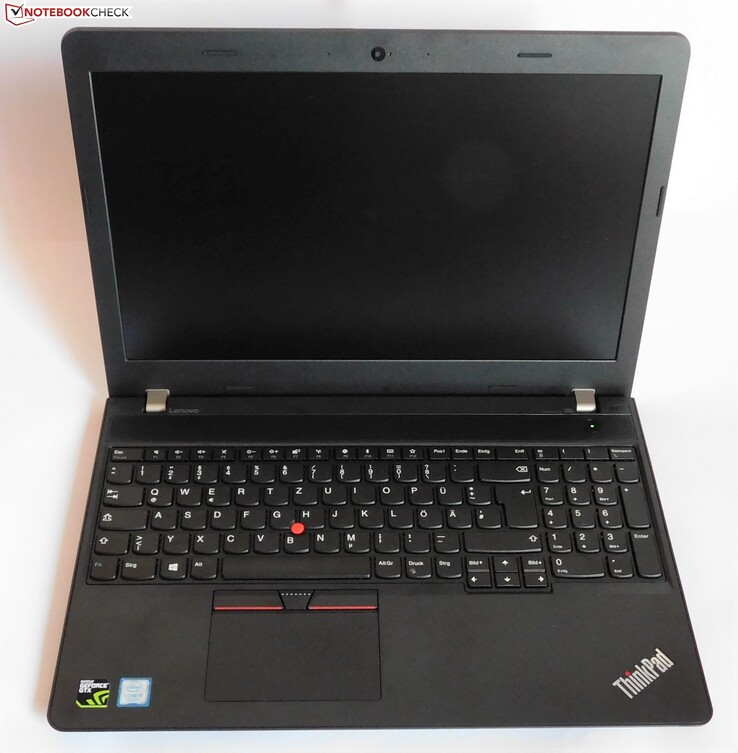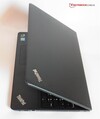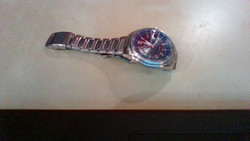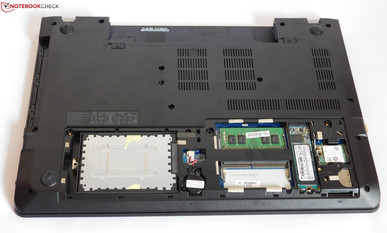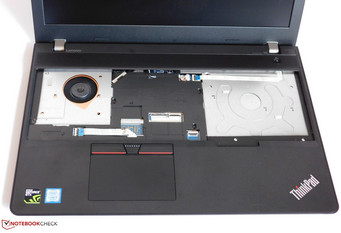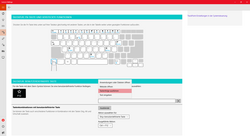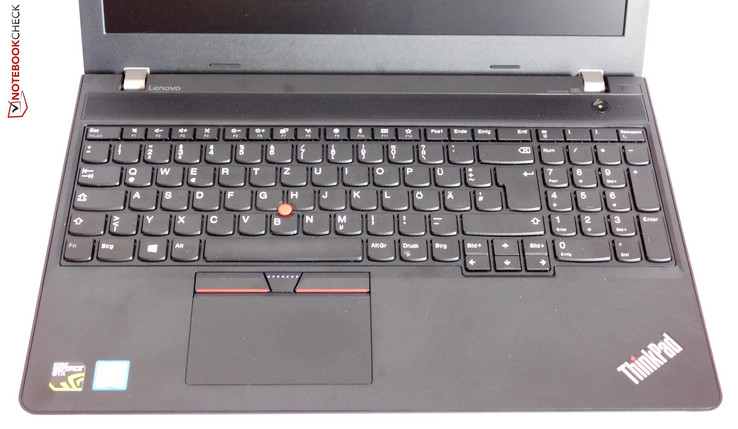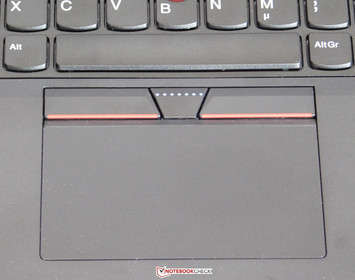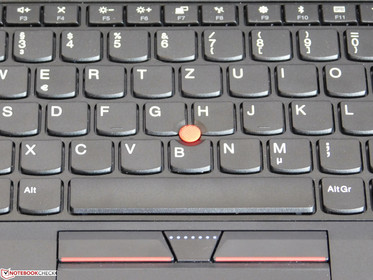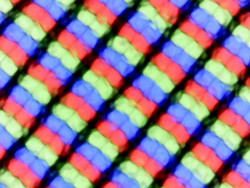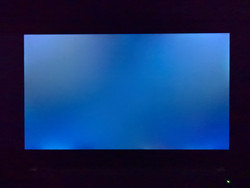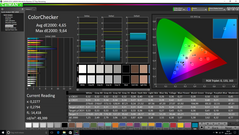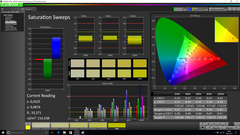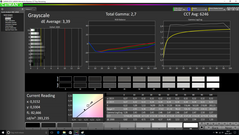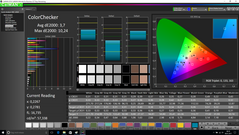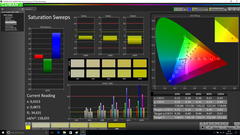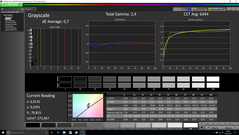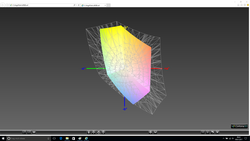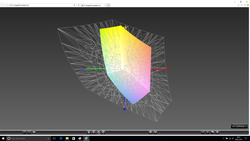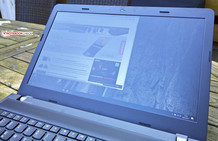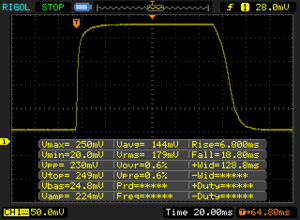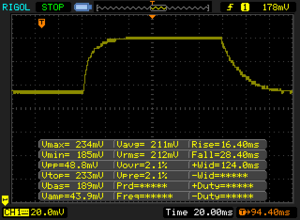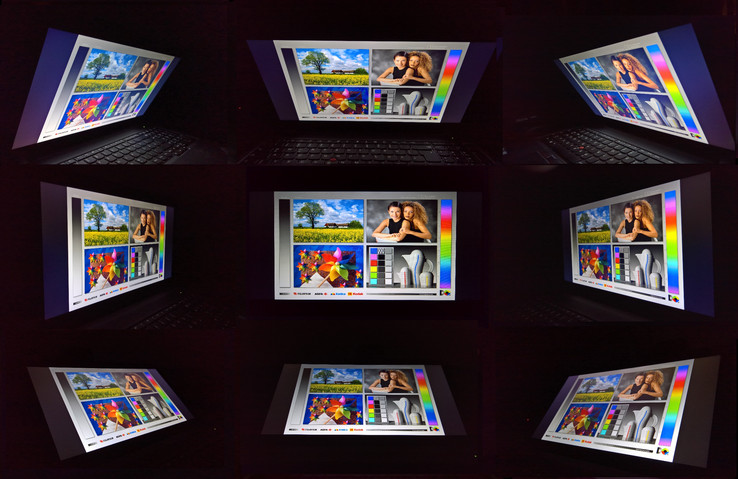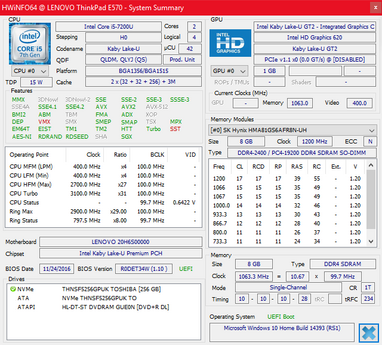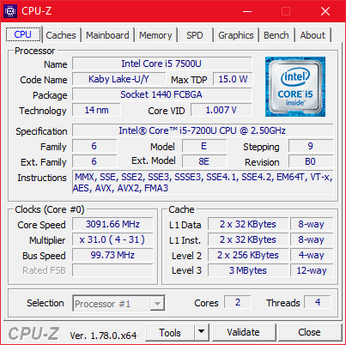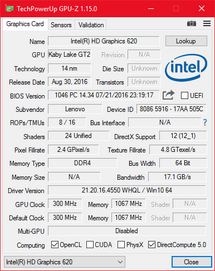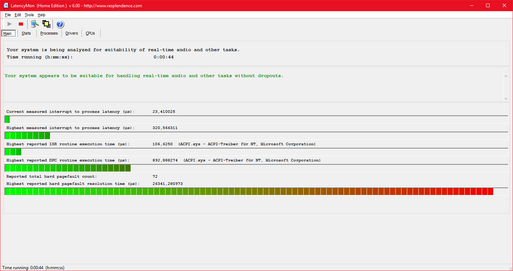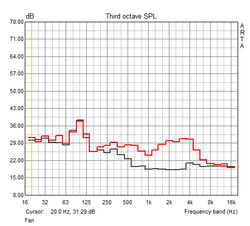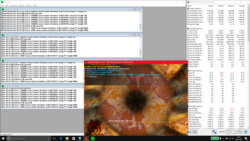Lenovo ThinkPad E570 (Core i5, GTX 950M) Notebook Review
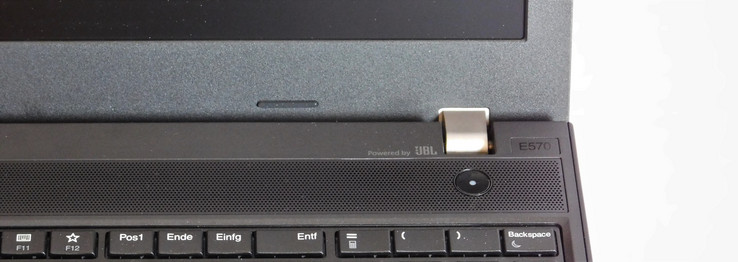
For the original German review, see here.
New year, new ThinkPads. It is almost tradition that the affordable ThinkPads from the E lineup (formerly ThinkPad Edge) are launched first on the market. They had already been announced in the fall of last year, while the more expensive ThinkPad T/X/L lineup followed shortly before the CES. Therefore, the ThinkPad E470 recently came to us as the first Kaby Lake ThinkPad for testing purposes, and now the bigger E570 follows.
The E570 is the direct successor of the E560 and represents the first larger update of the ThinkPad E500 series since the ThinkPad E550. The ThinkPad E lineup is the entry series in the ThinkPad range. Its low price is to primarily attract small businesses, private users, and students. The fact that the review sample is a special edition that is reduced in price for students matches to this.
Due to the installed GeForce GTX 950M, the review sample will be classified as a multimedia laptop although the ThinkPad lineup traditionally belongs to the office sector. Therefore, it is also logical to compare review samples from both categories. A direct rival from the office sector would be, for example, HP's ProBook 450 G4. Dell has its Latitude 3000 series that competes directly with the ThinkPad E lineup. However, we have to be satisfied with the Skylake-based Latitude 3570; a Kaby Lake successor has not yet been announced. Acer's Aspire E5-575G and Lenovo's IdeaPad 510-IKB would be suitable comparison devices from the multimedia sector.
Case
The ThinkPads come in a love it or leave it design - it is a classic in any case. Black as far as the eye can see still defines today's ThinkPad design. Lenovo was and is venturous with colors: The previous E generation was available in "Graphite Black", a lighter black shade. Earlier generations of the Edge lineup were even sold with red or blue display lids. Lenovo does a bit of experimenting with the E570, but not with our review sample. The devices that Lenovo offers normal customers on its website all have a silver wrist rest. Otherwise, the E570 follows the design line of former Edge E models, which means that it has rounded corners rather than the classic ThinkPad box shape.
The entire casing is made from plastic as is typical for a low-cost laptop. The base unit, display bezel, and wrist rest are made of a roughened plastic without a special finish; the buyer feels that the device is retailed at a low price. The display's plastic bezel conveys a somewhat higher-quality material impression thanks to its exterior coating. The lid feels velvety-soft in the hands.
However, this "soft" impression not only applies to the feel but also unfortunately to the stability. The thin lid cannot defy our twisting attempts very successfully. The base unit is slightly more stable, but not very stiff, either. It looks better when pinpoint pressure is applied to the wrist rest; it does not dent anywhere, and the keyboard is also very rigid. In return, pressure on the display lid is passed on to the screen almost immediately.
Unfortunately, the E570's build is not absolutely impeccable. The transition on the display lid, i.e. between the lid's back and display bezel, is a problem as the back protrudes marginally and leads to a palpable edge that is also a bit sharp in some places. Manufacturing has not been monitored quite as fastidiously as in the smaller E470 that did not present any weaknesses in build.
The hinges are also a downgrade compared with other ThinkPads. The silver plastic coverings do not make the same high-quality impression as the metal covers in more expensive models. Furthermore, the hinges ThinkPad-untypically only allow opening to 130 °. At least the hinges have a fairly good grip on the lid; it only rocks marginally in unsteady environments.
All laptops in the comparison are similar in both size and weight. Only the ProBook 450 G4 stands out - its weight of 2 kg makes it the lightest device in the comparison and roughly 300 grams lighter than the E570. Compared with the former E560, the ThinkPad E570 is slightly thinner and lighter but also marginally larger.
Connectivity
The E570 is a good example of how not to position interfaces. All interfaces are in the front area on both the right and left sides. Thus, mouse users will have problems when connecting something regardless of whether they are right or left-handed. Lenovo installs three USB Type-A ports, two of which are USB 3.0 ports. They are very close together on the left, making it difficult to connect several USB 3.0 peripherals. The user will have to be satisfied with USB 2.0 speed when evading to the left.
External monitors can be connected via VGA and HDMI. The review sample does not offer DisplayPort, which means that 4K monitors can be used at a maximum of 30 Hz. However, E570 models with DisplayPort exist: When selecting the Core i5-7200U during the ordering process, the device then allegedly comes with a USB Type-C port, which our review sample does not have, and DisplayPort support.
SD-Card Reader
The E570 only does a mediocre job in the SD-card benchmark that we perform with a Toshiba Exceria Pro SDXC 64 GB UHS-II reference memory card. It is roughly on par with HP's rival but far from very fast SD-card readers as, for example, in Dell's XPS 13. However, the SD-card reader in Dell's Latitude 3570 is much slower.
| SD Card Reader | |
| average JPG Copy Test (av. of 3 runs) | |
| Dell XPS 13 9360 FHD i5 | |
| HP ProBook 450 G4 Y8B60EA | |
| Lenovo ThinkPad E570-20H6S00000 | |
| Dell Latitude 15-3570 | |
| maximum AS SSD Seq Read Test (1GB) | |
| Dell XPS 13 9360 FHD i5 | |
| HP ProBook 450 G4 Y8B60EA | |
| Lenovo ThinkPad E570-20H6S00000 | |
| Dell Latitude 15-3570 | |
Communication
The Atheros QCA6174 that Lenovo also calls Qualcomm 344A-AC is a 2x2 AC Wi-Fi card with integrated Bluetooth 4.2. Lenovo offers two other Wi-Fi modules besides this Wi-Fi card: Intel's 8265AC as another 2x2 card and Qualcomm's 435-AC. The latter is a cheaper 1x1 card. The buyer should make sure that a 2x2 card is installed when purchasing the device. The best choice is probably Intel's card. The Qualcomm/Atheros 2x2 card also does a relatively good job, though. Irregularities were not observed in everyday use, and it had a clear lead on the Qualcomm/Atheros 1x1 card in Acer's Spin 5. In addition to the Wi-Fi module, a Gigabit Ethernet port that functions reliably is also installed.
The typical setup for laptops is found in webcam and microphones: The webcam is inferior and the microphones are satisfactory. The webcam's photos are blurry and low-contrast; the microphones record voices loudly and clearly.
| Networking | |
| iperf3 receive AX12 | |
| Lenovo ThinkPad E570-20H6S00000 | |
| Acer Spin 5 SP513-51 | |
| HP 15-ba077ng | |
| iperf3 transmit AX12 | |
| Lenovo ThinkPad E570-20H6S00000 | |
| Acer Spin 5 SP513-51 | |
| HP 15-ba077ng | |
Security
Being a device that is also aimed at businesses but with more focus on private users, the E570 comes with some security features. Our review sample sports a Kensington lock, TPM, BIOS passwords, and CompuTrace support. The E570 allegedly also exists with an optional fingerprint scanner, but this was not present in our review sample. Buyers will have to opt for one of the more expensive ThinkPad lineups for features like a SmartCard reader or infrared camera.
Accessories
Lenovo does not include any accessories. Since the device does not feature USB Type-C or a dedicated, mechanical docking port, no manufacturer-specific docks apart from USB 3.0 docks, such as this one, exist. Models with USB Type-C ports can make use of the newly announced Lenovo USB Type-C docking station that also recharges the laptop.
Maintenance
Being a traditional laptop, the E570 differs from many modern ultrabooks in terms of maintainability. While the entire base plate often has to be removed for accessing the components in the latter, the E570 has a maintenance hatch that is quite easy to remove after releasing two screws. This allows accessing the 2.5-inch hard drive (a dummy was inserted into the slot in our model), the working memory, the 2280M M.2 SSD, and the Wi-Fi module. The only drawback on the topic of maintainability: The fan is not as easy to reach; the system has to be disassembled even further for this. The cooling system remains inaccessible even after taking out the easy to remove keyboard. The comprehensive E570 Hardware Maintenance Manual should be consulted for this undertaking.
The E570 has an external, easy to remove battery as is typical for a classic laptop. Many other systems are furnished with internal batteries nowadays.
Warranty
The E570 comes with a 12-month warranty ex-factory. It is a bring-in service, i.e. the user has to send the laptop to the manufacturer in case of defects. Lenovo offers various warranty extensions: An on-site service where a technician repairs the laptop at home, a warranty upgrade up to fpur years, and an accidental damage warranty that also covers damages due to drops. All warranty extensions are listed on Lenovo's website.
Please see our Guarantees, Return Policies and Warranties FAQ for country-specific information.
Input Devices
Keyboard
Lenovo installs a six-row keyboard with numpad and the typical, lightly concave chiclet keys into the ThinkPad E570. Lenovo calls this keyboard "Precision Keyboard". Almost all keys are standard sized, and only the arrow keys are somewhat smaller, which is not as adverse here as is the case with many other manufacturers. Lenovo has modified the layout for the first time since 2013 this year, although it is only a minor modification. It concerns the function keys F10 to F12. Generic Windows functions that came from the Windows 8 era were mapped on these keys in the former generation. In the new generation, F10 disables Bluetooth, and F11 and F12 are interlinked: F12 displays a star symbol, and it is a configurable special key that can be mapped with different functions. These settings can be performed in the preloaded Lenovo settings app that is opened via F11. Otherwise, the print key that now opens Windows' Snipping Tool when pressed simultaneously with FN has to be mentioned here.
ThinkPad keyboards are famous for their good typing feel, and the E570 is not an exception. However, it must be said that the keyboards in the more expensive ThinkPad lineups are even slightly better. In comparison, the keyboard feels a bit spongier and the drop is marginally shorter. The pressure point is not as well-defined and the stroke noise is rather muffled. Nevertheless, the keyboard is a relief compared with many other laptops in the E570's price range.
The keys have a somewhat rough feel to them. This is likely because the E570, like all E models, does not have a backlit keyboard, and this is not optionally available, either. The backlit keyboards in the more expensive ThinkPads often have relatively sleek surfaces by comparison.
Touchpad and TrackPoint
One big innovation of this ThinkPad generation is its touchpad. Although nothing has changed about the touchpad's direct design, which is still a ClickPad without dedicated keys, Lenovo has converted the touchpads to Microsoft's Precision Touchpad Standard in the 2017 ThinkPads. Thus, the touchpad settings have moved to the native Windows settings app. It was possible to configure it in the manufacturer-specific setting windows in system control before. This has the following consequences for everyday use: The problems of former touchpad and ClickPad implementations have been eliminated. Multitouch gestures, two-finger scrolling, and pinch-to-zoom now function impeccably - almost on par with MacBooks by Apple.
The hardware of the E570 seems identical with that of the E470. We determined the same qualities here: An even surface with high sleekness and a crisp, solid key mechanism - this is what makes good ClickPads.
Of course, Lenovo installs the known ThinkPad TrackPoint besides the touchpad. This is a unique selling point in the low-cost price range. The TrackPoint allows accurate and fast mouse control, and the corresponding mouse keys make a high-quality impression. They click very quietly but do not feel spongy. It remains a matter of taste whether the touchpad or the TrackPoint is preferred. In any case, it is positive that Lenovo still customarily installs the TrackPoint in all ThinkPads. After all, it is an additional option for mouse control that can be used or not.
Display
Lenovo offers two different display options for the E570. Both are matte and non-touch: firstly, a 15.6-inch LCD with HD resolution (1366x768 pixels) based on TN technology. This option is intended for the cheapest E570 models. Secondly, a 15.6-inch screen with a resolution of 1920x1080 pixels (Full HD) based on IPS. Fortunately, the second version is installed into our review sample. Lenovo uses three different FHD panels from different manufacturers; ours is the model number B156HAN04.4 and comes from AUO.
According to Lenovo, the screen should achieve a brightness of 250 cd/m². In fact, it reaches and even surpasses this with a maximum of 289 cd/m². However, the screen only achieves an illumination of 75% which drops slightly toward the lower edge, but which is fortunately not visible during use. The screen achieves an average brightness of 244 cd/m², which is quite acceptable for the price range. PWM was not observed in the screen, and backlight bleeding was only very lightly visible at the lower edge (a bit exaggerated in the screenshot).
Compared with the competition, the screen in the E570 scores well. The devices by Acer, HP, and Dell are furnished with TN screens that generally are poorer in quality. The E570 is slightly superior to its predecessor that was also equipped with an FHD IPS panel.
| |||||||||||||||||||||||||
Brightness Distribution: 75 %
Center on Battery: 245 cd/m²
Contrast: 1008:1 (Black: 0.24 cd/m²)
ΔE ColorChecker Calman: 4.65 | ∀{0.5-29.43 Ø4.78}
ΔE Greyscale Calman: 3.39 | ∀{0.09-98 Ø5}
57.66% sRGB (Argyll 1.6.3 3D)
36.69% AdobeRGB 1998 (Argyll 1.6.3 3D)
39.94% AdobeRGB 1998 (Argyll 3D)
58% sRGB (Argyll 3D)
38.65% Display P3 (Argyll 3D)
Gamma: 2.7
CCT: 6246 K
| Lenovo ThinkPad E570-20H6S00000 AUO B156HAN04.4, , 1920x1080, 15.6" | Lenovo ThinkPad E560 20EV000XPB LG Display LEN40BA / LP156WF6-SPK1, , 1920x1080, 15.6" | HP ProBook 450 G4 Y8B60EA Chi Mei CMN15C4, , 1920x1080, 15.6" | Dell Latitude 15-3570 LG Philips LGD04AF / 156WHU, , 1366x768, 15.6" | Acer Aspire E5-575G-549D Chi Mei CMN15C4, , 1920x1080, 15.6" | Lenovo IdeaPad 510-15IKB 80SV0087GE BOE HF NV156FHM-N42, , 1920x1080, 15.6" | |
|---|---|---|---|---|---|---|
| Display | -7% | 3% | 5% | -0% | 10% | |
| Display P3 Coverage (%) | 38.65 | 36.05 -7% | 39.89 3% | 40.61 5% | 38.57 0% | 42.66 10% |
| sRGB Coverage (%) | 58 | 53.2 -8% | 59.5 3% | 61.1 5% | 57.4 -1% | 64.1 11% |
| AdobeRGB 1998 Coverage (%) | 39.94 | 37.4 -6% | 41.24 3% | 41.96 5% | 39.89 0% | 44.08 10% |
| Response Times | -16% | -14% | 10% | -31% | ||
| Response Time Grey 50% / Grey 80% * (ms) | 44.8 ? | 51 ? -14% | 37 ? 17% | 39 ? 13% | 51 ? -14% | |
| Response Time Black / White * (ms) | 25.6 ? | 30 ? -17% | 37 ? -45% | 24 ? 6% | 38 ? -48% | |
| PWM Frequency (Hz) | 50 ? | 50 ? | ||||
| Screen | -3% | -60% | -80% | -50% | 9% | |
| Brightness middle (cd/m²) | 242 | 332.2 37% | 214 -12% | 202 -17% | 176 -27% | 291 20% |
| Brightness (cd/m²) | 243 | 301 24% | 201 -17% | 211 -13% | 169 -30% | 265 9% |
| Brightness Distribution (%) | 75 | 80 7% | 77 3% | 88 17% | 91 21% | 86 15% |
| Black Level * (cd/m²) | 0.24 | 0.4 -67% | 0.43 -79% | 0.62 -158% | 0.47 -96% | 0.23 4% |
| Contrast (:1) | 1008 | 831 -18% | 498 -51% | 326 -68% | 374 -63% | 1265 25% |
| Colorchecker dE 2000 * | 4.65 | 10.68 -130% | 12.35 -166% | 8.83 -90% | 4.78 -3% | |
| Colorchecker dE 2000 max. * | 9.64 | 18.07 -87% | 19.9 -106% | 14.01 -45% | 9.51 1% | |
| Greyscale dE 2000 * | 3.39 | 11.32 -234% | 13.46 -297% | 8.97 -165% | 3.49 -3% | |
| Gamma | 2.7 81% | 2.26 97% | 2.44 90% | 2.43 91% | 2.58 85% | |
| CCT | 6246 104% | 12204 53% | 15217 43% | 10234 64% | 6013 108% | |
| Color Space (Percent of AdobeRGB 1998) (%) | 36.69 | 38 4% | 39 6% | 36.8 0% | 40 9% | |
| Color Space (Percent of sRGB) (%) | 57.66 | 59 2% | 61 6% | 57.3 -1% | 64 11% | |
| Total Average (Program / Settings) | -5% /
-5% | -24% /
-42% | -30% /
-54% | -13% /
-32% | -4% /
4% |
* ... smaller is better
The screen's black level is good, and the contrast of AUO's panel is almost on par with a very good IPS screen. The screen's subjective quality impression is also convincing.
The reproducible color space prevents the screen from playing in the league of premium IPS LCDs. 57% of sRGB is on the level with very low-cost panels. Consequently, it is unsuitable for serious image editing.
Display Response Times
| ↔ Response Time Black to White | ||
|---|---|---|
| 25.6 ms ... rise ↗ and fall ↘ combined | ↗ 6.8 ms rise | |
| ↘ 18.8 ms fall | ||
| The screen shows relatively slow response rates in our tests and may be too slow for gamers. In comparison, all tested devices range from 0.1 (minimum) to 240 (maximum) ms. » 60 % of all devices are better. This means that the measured response time is worse than the average of all tested devices (20.2 ms). | ||
| ↔ Response Time 50% Grey to 80% Grey | ||
| 44.8 ms ... rise ↗ and fall ↘ combined | ↗ 16.4 ms rise | |
| ↘ 28.4 ms fall | ||
| The screen shows slow response rates in our tests and will be unsatisfactory for gamers. In comparison, all tested devices range from 0.165 (minimum) to 636 (maximum) ms. » 75 % of all devices are better. This means that the measured response time is worse than the average of all tested devices (31.6 ms). | ||
Screen Flickering / PWM (Pulse-Width Modulation)
| Screen flickering / PWM not detected | ||
In comparison: 53 % of all tested devices do not use PWM to dim the display. If PWM was detected, an average of 8111 (minimum: 5 - maximum: 343500) Hz was measured. | ||
Since this is an IPS panel, the viewing angles are very good and cannot be compared with low-cost TN screens. A light bluish tint is visible when looking down at the screen from the side. However, this is not dramatic and hardly significant for everyday use.
Connecting external monitors via HDMI and VGA functioned impeccably.
Performance
Lenovo sells the E570 in six different, invariable configurations in Germany at retailers. The ThinkPad can also be configured in Lenovo's own shop. Two of the fixed configurations are intended exclusively for students, and we are testing the cheaper one of the student models.
Lenovo installs either the Core i5-7200U or Core i7-7500U in the fixed configurations. It is also possible to select the Core i3-7100U or Core i3-6006U Skylake processors in Lenovo's configuration tool. According to Lenovo, the latter is available for compatibility with Windows 7.
The graphics chips have a similar configuration diversity: Intel's HD 620 is installed in all models, except for the model based on the Skylake processor that logically comes with the older Intel HD 520. Lenovo additionally offers two different dedicated graphics chips by Nvidia: the GeForce GTX 950M and GeForce 940MX that is exclusively available in Lenovo's web shop.
Since the E570 has an M.2 slot for NVMe SSDs and a 2.5-inch slot for hard drives, the laptop can be configured quite flexibly and can also be upgraded by the user after purchase. Up to 1-TB HDDs and 256-GB NVMe SSDs are available, separately in the fixed configurations and combinable ex-factory in Lenovo's configurator.
The ThinkPad E570 has the typical RAM configuration of a traditional laptop: two RAM slots. The RAM is a DDR4-2400 memory that clocks at 2133 MHz (effectively). Lenovo offers up to 16 GB ex-factory, but users can upgrade the RAM to at most 32 GB.
Processor
A Core i5-7200U is inside the review sample. It is an often-used mid-range processor from Intel's U CPU lineup. All U CPUs are classified with a TDP of 15 watts and can thus be seen as ULV (ultra-low voltage) CPUs. These CPUs were initially designed exclusively for thin ultrabooks, but they are now also standard in normal laptops. The processor features Hyper-Threading and Turbo Boost. Its base clock is 2.5 GHz, and the CPU can clock at up to 3.1 GHz via Turbo Boost.
The processor can utilize its potential ideally in the Cinebench test. The CPU clocks at its maximum speed of 3.1 GHz during the entire multi-core test. The E570 is exactly on par with Acer's Aspire E5-575G that sports the same CPU. The former E560 with an i7-6500U is almost matched. Performance losses were not determined in battery mode.
More information and comparisons with other CPUs can be found in our CPU benchmark list.
| Cinebench R15 | |
| CPU Single 64Bit | |
| Lenovo IdeaPad 510-15IKB 80SV0087GE | |
| HP ProBook 450 G4 Y8B60EA | |
| Lenovo ThinkPad E560 20EV000XPB | |
| Acer Aspire E5-575G-549D | |
| Lenovo ThinkPad E570-20H6S00000 | |
| Dell Latitude 15-3570 | |
| CPU Multi 64Bit | |
| HP ProBook 450 G4 Y8B60EA | |
| Lenovo IdeaPad 510-15IKB 80SV0087GE | |
| Acer Aspire E5-575G-549D | |
| Lenovo ThinkPad E570-20H6S00000 | |
| Lenovo ThinkPad E560 20EV000XPB | |
| Dell Latitude 15-3570 | |
System Performance
Subjectively, the system performance is very good, and there are no prolonged waiting times during work. The E570 also places itself almost at the top in the comparison with its direct rivals, which is probably due to the fast NVMe SSD.
| PCMark 8 | |
| Home Score Accelerated v2 | |
| Lenovo IdeaPad 510-15IKB 80SV0087GE | |
| Lenovo ThinkPad E570-20H6S00000 | |
| Dell Latitude 15-3570 | |
| HP ProBook 450 G4 Y8B60EA | |
| Acer Aspire E5-575G-549D | |
| Work Score Accelerated v2 | |
| HP ProBook 450 G4 Y8B60EA | |
| Lenovo ThinkPad E570-20H6S00000 | |
| Dell Latitude 15-3570 | |
| Acer Aspire E5-575G-549D | |
| PCMark 8 Home Score Accelerated v2 | 3550 points | |
| PCMark 8 Work Score Accelerated v2 | 4666 points | |
Help | ||
Storage Device
Lenovo installs a 256 GB SSD. It is a fast PCIe NVMe SSD by Toshiba with the model number THNSF5256GPUK. It is much faster than the SATA III SSDs installed in the comparison devices, which is also reflected in the benchmarks. The former E560 with the low-cost and slow CM871 SSD by Samsung is clearly outperformed.
| Lenovo ThinkPad E570-20H6S00000 Toshiba THNSF5256GPUK | Lenovo ThinkPad E560 20EV000XPB Samsung CM871 MZ7LF192HCGS | HP ProBook 450 G4 Y8B60EA SanDisk SD8SNAT256G1002 | Dell Latitude 15-3570 Samsung CM871 MZNLF128HCHP | Lenovo IdeaPad 510-15IKB 80SV0087GE Liteonit CV3-DE256 | |
|---|---|---|---|---|---|
| AS SSD | -70% | -46% | -75% | -33% | |
| Seq Read (MB/s) | 1227 | 489.5 -60% | 493.8 -60% | 489.1 -60% | 479.8 -61% |
| Seq Write (MB/s) | 636 | 169.9 -73% | 315.9 -50% | 130 -80% | 377.8 -41% |
| 4K Read (MB/s) | 37.12 | 17.46 -53% | 17.96 -52% | 17.25 -54% | 32.4 -13% |
| 4K Write (MB/s) | 73.1 | 34.76 -52% | 73.4 0% | 21.57 -70% | 59.7 -18% |
| 4K-64 Read (MB/s) | 654 | 84.6 -87% | 137.1 -79% | 81.8 -87% | 345.5 -47% |
| 4K-64 Write (MB/s) | 232.5 | 33.68 -86% | 195.5 -16% | 19.37 -92% | 203.7 -12% |
| Score Total (Points) | 1578 | 305 -81% | 607 -62% | 267 -83% | 951 -40% |
Graphics Card
The GeForce GTX 950M in our review sample is an upper mid-range graphics solution, whereby we have to point out from last year's upper mid-range. After all, more and more Pascal-based GPUs, such as the GeForce GTX 1050, are being launched on the market. The 950M is still based on the Maxwell architecture.
The 640 Shader units clock at a maximum of 914 MHz, which is also achieved in the benchmarks. The E570 not only surpasses its predecessor, which was still furnished with an AMD GPU (AMD Radeon R7 M370), clearly in the 3DMark test, HP's ProBook 450 G4 with a GeForce 930MX is also left far behind. Like the CPU, performance losses in battery mode were not observed.
Again we refer to the GPU benchmark page that allows comparing more graphics chips.
| 3DMark 11 - 1280x720 Performance GPU | |
| Acer Aspire E5-575G-549D | |
| Lenovo ThinkPad E570-20H6S00000 | |
| Lenovo ThinkPad E560 20EV000XPB | |
| Lenovo IdeaPad 510-15IKB 80SV0087GE | |
| HP ProBook 450 G4 Y8B60EA | |
| Dell Latitude 15-3570 | |
| 3DMark | |
| 1280x720 Cloud Gate Standard Graphics | |
| Acer Aspire E5-575G-549D | |
| Lenovo ThinkPad E570-20H6S00000 | |
| Lenovo ThinkPad E560 20EV000XPB | |
| HP ProBook 450 G4 Y8B60EA | |
| Dell Latitude 15-3570 | |
| 1920x1080 Fire Strike Graphics | |
| Acer Aspire E5-575G-549D | |
| Lenovo ThinkPad E570-20H6S00000 | |
| Lenovo ThinkPad E560 20EV000XPB | |
| HP ProBook 450 G4 Y8B60EA | |
| 3DMark 11 Performance | 4255 points | |
| 3DMark Cloud Gate Standard Score | 10297 points | |
| 3DMark Fire Strike Score | 3244 points | |
Help | ||
Gaming Performance
Thanks to the GPU that is quite strong for a business laptop, even up-to-date games are playable. However, maximum details in the latest games will naturally not be possible. That would be possible with older games. Users who want even more gaming power will have to look among gaming laptops or mobile workstations that are, however, correspondingly more expensive, heavier, and bigger.
| low | med. | high | ultra | |
|---|---|---|---|---|
| BioShock Infinite (2013) | 138.1 | 95.4 | 86.8 | 35.66 |
| Company of Heroes 2 (2013) | 47.25 | 40.03 | 27.41 | 16.89 |
| Rise of the Tomb Raider (2016) | 71.4 | 40.32 | 21.2 |
Emissions
System Noise
The fan is permanently inactive in idle mode as it should be. On the other hand, the fan speeds up audibly without reaching a very annoying noise level during load. The fan noise is not high-pitched, and we did not observe pulsing or the like in our review sample.
The other potential noise source, i.e. the HDD, is not present in our device. Owners of an E570 with an HDD will likely have to live with permanent noise even in idle mode.
Noise level
| Idle |
| 29 / 29 / 29 dB(A) |
| Load |
| 34.3 / 40.1 dB(A) |
 | ||
30 dB silent 40 dB(A) audible 50 dB(A) loud |
||
min: | ||
Temperature
The device is not only quiet but is also cool when it is not loaded. The CPU is relatively energy-saving and does not produce much heat compared with stronger quad-core processors. Furthermore, the GeForce GPU as another heat source remains disabled in idle mode. This naturally changes during load where the temperature increases strongly, with up to almost 50 °C in some places on the underside.
The stress test with FurMark and Prime95 also proves that the cooling system is not able to cope with simultaneous processor and GPU load. The CPU initially clocks at its Turbo speed of 3.1 GHz. It drops to 2.8 GHz after a few minutes, which is still over the base clock. However, this changes after about 15 minutes: The processor reaches 91 °C, which is the maximum temperature that is reached in the stress test. At this point, the CPU immediately reduces its clock and temperature-related throttling sets in. The CPU drops to 1.4 GHz where it remains until the processor gradually cools down again. After reaching around 65 °C, the CPU suddenly increases its clock to 3.1 GHz only to drop to 1.4 GHz as soon as 91 °C is reached. This recurrently happened during the one-hour stress test. The GPU also throttles. It drops to about 700 MHz from 915 MHz shortly after initiating the test.
A Cinebench test performed directly after finishing the stress test resulted in the normal score.
(-) The maximum temperature on the upper side is 46.6 °C / 116 F, compared to the average of 36.9 °C / 98 F, ranging from 21.1 to 71 °C for the class Multimedia.
(-) The bottom heats up to a maximum of 49.1 °C / 120 F, compared to the average of 39.2 °C / 103 F
(+) In idle usage, the average temperature for the upper side is 23.1 °C / 74 F, compared to the device average of 31.3 °C / 88 F.
(+) The palmrests and touchpad are reaching skin temperature as a maximum (35.3 °C / 95.5 F) and are therefore not hot.
(-) The average temperature of the palmrest area of similar devices was 28.7 °C / 83.7 F (-6.6 °C / -11.8 F).
Speakers
One of the features that place the E570 in the multimedia sector is its speakers. The big stereo speakers above the keyboard naturally come from JBL. Their maximum volume is convincing, and their sound does not distort at higher volumes. The only real drawback: the speakers lack bass, but this is true for most laptop speakers.
The speakers are quite suitable for a video on-the-go, for example in a hotel room. Of course, external speakers or headphones can always be connected for a better sound experience.
Lenovo ThinkPad E570-20H6S00000 audio analysis
(±) | speaker loudness is average but good (80.7 dB)
Bass 100 - 315 Hz
(-) | nearly no bass - on average 16.8% lower than median
(-) | bass is not linear (16.4% delta to prev. frequency)
Mids 400 - 2000 Hz
(±) | higher mids - on average 5.1% higher than median
(±) | linearity of mids is average (9.5% delta to prev. frequency)
Highs 2 - 16 kHz
(+) | balanced highs - only 2.7% away from median
(+) | highs are linear (6.5% delta to prev. frequency)
Overall 100 - 16.000 Hz
(±) | linearity of overall sound is average (19.6% difference to median)
Compared to same class
» 62% of all tested devices in this class were better, 8% similar, 30% worse
» The best had a delta of 5%, average was 17%, worst was 45%
Compared to all devices tested
» 48% of all tested devices were better, 7% similar, 45% worse
» The best had a delta of 4%, average was 24%, worst was 134%
Apple MacBook 12 (Early 2016) 1.1 GHz audio analysis
(+) | speakers can play relatively loud (83.6 dB)
Bass 100 - 315 Hz
(±) | reduced bass - on average 11.3% lower than median
(±) | linearity of bass is average (14.2% delta to prev. frequency)
Mids 400 - 2000 Hz
(+) | balanced mids - only 2.4% away from median
(+) | mids are linear (5.5% delta to prev. frequency)
Highs 2 - 16 kHz
(+) | balanced highs - only 2% away from median
(+) | highs are linear (4.5% delta to prev. frequency)
Overall 100 - 16.000 Hz
(+) | overall sound is linear (10.2% difference to median)
Compared to same class
» 7% of all tested devices in this class were better, 2% similar, 91% worse
» The best had a delta of 5%, average was 18%, worst was 53%
Compared to all devices tested
» 4% of all tested devices were better, 1% similar, 94% worse
» The best had a delta of 4%, average was 24%, worst was 134%
Frequency diagram in comparison (checkboxes above can be turned on/off!)
Energy Management
Power Consumption
The review sample proves to be very efficient in idle and scores better than all listed devices. This naturally looks different during load. The GeForce GTX 950M increases the power consumption strongly compared with other devices. However, it must be said that the E570 is not excessively wasteful: Acer's E5-575G based on the same GPU and CPU combination consumes much more during full load.
The 90-watt power supply is more than sufficiently sized.
| Off / Standby | |
| Idle | |
| Load |
|
Key:
min: | |
| Lenovo ThinkPad E570-20H6S00000 i5-7200U, GeForce GTX 950M, Toshiba THNSF5256GPUK, IPS LED, 1920x1080, 15.6" | Lenovo ThinkPad E560 20EV000XPB 6500U, Radeon R7 M370, Samsung CM871 MZ7LF192HCGS, IPS, 1920x1080, 15.6" | HP ProBook 450 G4 Y8B60EA i7-7500U, GeForce 930MX, SanDisk SD8SNAT256G1002, TN LED, 1920x1080, 15.6" | Dell Latitude 15-3570 6200U, HD Graphics 520, Samsung CM871 MZNLF128HCHP, TN LED, 1366x768, 15.6" | Acer Aspire E5-575G-549D i5-7200U, GeForce GTX 950M, Toshiba MQ01ABD100, TN, 1920x1080, 15.6" | Lenovo IdeaPad 510-15IKB 80SV0087GE i7-7500U, GeForce 940MX, Liteonit CV3-DE256, IPS, 1920x1080, 15.6" | |
|---|---|---|---|---|---|---|
| Power Consumption | -29% | -9% | 3% | -41% | -8% | |
| Idle Minimum * (Watt) | 2.8 | 3.6 -29% | 3.8 -36% | 4.9 -75% | 6 -114% | 3.9 -39% |
| Idle Average * (Watt) | 6.3 | 8.7 -38% | 6.6 -5% | 7.2 -14% | 8.1 -29% | 7.4 -17% |
| Idle Maximum * (Watt) | 6.9 | 11.5 -67% | 11.3 -64% | 7.5 -9% | 9.8 -42% | 9.5 -38% |
| Load Average * (Watt) | 51.6 | 61.9 -20% | 38 26% | 25.4 51% | 52.5 -2% | 41 21% |
| Load Maximum * (Watt) | 69.7 | 64.8 7% | 45 35% | 28 60% | 81.6 -17% | 48 31% |
* ... smaller is better
Battery Runtime
Lenovo uses a lithium-ion battery with a capacity of 41 watt-hours. This battery lifts the laptop's rear slightly. Lenovo also offers a smaller 32-watt hour battery (lithium-polymer) that will probably not lift the device.
It could actually be presumed that the E570 does not achieve very good runtimes due to its small battery. However, as said, it is quite energy saving. Consequently, the battery life is relatively good. 7 hours and 42 minutes in the Wi-Fi test is a suitable outcome for a low-cost laptop. Dell's Latitude 3570 is considerably better, but it also has a much bigger 65-Wh battery.
| Lenovo ThinkPad E570-20H6S00000 i5-7200U, GeForce GTX 950M, 41 Wh | Lenovo ThinkPad E560 20EV000XPB 6500U, Radeon R7 M370, 48 Wh | HP ProBook 450 G4 Y8B60EA i7-7500U, GeForce 930MX, 45 Wh | Dell Latitude 15-3570 6200U, HD Graphics 520, 65 Wh | Acer Aspire E5-575G-549D i5-7200U, GeForce GTX 950M, 62 Wh | Lenovo IdeaPad 510-15IKB 80SV0087GE i7-7500U, GeForce 940MX, 30 Wh | |
|---|---|---|---|---|---|---|
| Battery runtime | -10% | -3% | 17% | -19% | -40% | |
| Reader / Idle (h) | 14.7 | 13.2 -10% | 12.4 -16% | 17.1 16% | 12.8 -13% | |
| WiFi v1.3 (h) | 7.7 | 8.6 12% | 9 17% | 7.5 -3% | 4.6 -40% | |
| Load (h) | 2.2 | 2.1 -5% | 2.6 18% | 1.3 -41% | ||
| WiFi (h) | 5.5 | |||||
| H.264 (h) | 7.7 |
Pros
Cons
Verdict
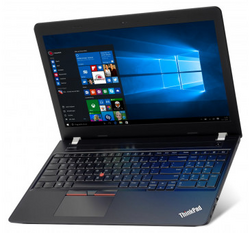
The E570, in fact, has many qualities that speak for the first 15.6-inch Kaby Lake ThinkPad on the market: The decent input devices are a main argument. Lenovo does not make any major mistakes with the screen; the limited color space can be excused in a low-cost device when the screen scores well otherwise (and it does). Maintaining the E570 is quite easy, the good speakers, and the comparatively strong graphics card add multimedia qualities to the device. Furthermore, we discovered that the device is always cool and quiet in idle and during low load.
Unfortunately, Lenovo makes some mistakes: The port positioning is anything but ideal although it would have been quite possible to distribute the interfaces differently despite the DVD drive. The CPU and GPU throttle massively during load, which points to a too weak cooling system. Finally, we have to criticize the casing: In particular, the display housing does not convince in either build or stability.
Too bad that Lenovo makes such mistakes in terms of build. The E570 is actually a very interesting device primarily for students - however, the smaller E470 might just be even more attractive.
Nevertheless, a purchase recommendation can be given for the E570 in total due to the good price-performance ratio. It could be interesting mainly for students and private users who want a laptop with good input devices. However, the price-performance ratio is not as good for non-students: The fixed configurations start at 750 Euros (~$798) and do not offer an SSD but only the 1-TB HDD, and they do not have a dedicated GPU. At least the weaker 940MX is installed when ordering directly from Lenovo. HP's ProBook 450 G4 starts at an overall lower price but also comes with an inferior TN screen.
Lenovo ThinkPad E570-20H6S00000
- 02/03/2017 v6 (old)
Benjamin Herzig




